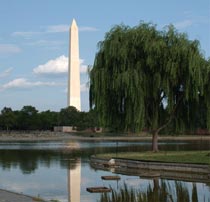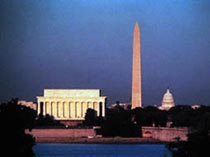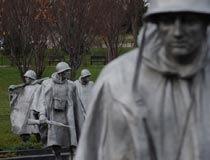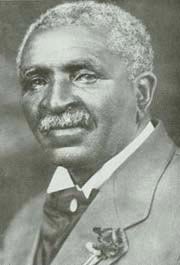| (insert your NIE or newspaper logo here) |
Weekly Online LessonOnline Lesson ArchiveGrade Level: 5-12
|
American Landmarks: The History of the People
 Last week, a proposal to tighten national security collided with pleas to maintain a national freedom. In this case, the freedom centers around people's ability to fully enjoy and honor an important historical place.
Last week, a proposal to tighten national security collided with pleas to maintain a national freedom. In this case, the freedom centers around people's ability to fully enjoy and honor an important historical place.
The Washington Monument has stood as an American symbol of history and identity since 1885, as a memorial to former President George Washington. The monument soars over 555 feet into the sky -- an awe-inspiring image for visitors standing at its base. Meanwhile, its 896 steps lead visitors to a bird's-eye view of the capital city.
But on Thursday, April 30, 2003, The National Capital Planning Commission announced their preliminary approval to plan for a tunnel to the Washington Monument. The tunnel would become the only access to the monument, designed to meet the area's new security needs.
 More than a dozen engineers, tour guides and citizens showed up at the meeting to oppose the project.
More than a dozen engineers, tour guides and citizens showed up at the meeting to oppose the project.
"Would you rather enter the monument 500 feet away, through a tunnel as long as the monument is high?" asked Dr. Judy Feldman, with the National Coalition to Save Our Mall. "Or would you prefer walking up the monument and entering through the front door, as people have for decades?"
The tunnel would not be in place until after 2005, and the plans still need final approval from the commission. However, this is just one example of where Americans are trying to balance the need for security with the need for access to landmarks that remind us of the people, places and events that have shaped the nation.
During this week's lesson, you'll tour several important monuments at the National Mall in Washington D.C. and explore the history behind them. Then you'll travel across the country and discover landmarks centered around other historical figures.
The National Mall
 When visiting the nation's capital, the National Mall is a must-see part of the city. The area is home to a variety of museums, such as the National Museum of Natural History and the National Gallery of Art, but it also features several monuments dedicated to important people in the nation's history.
When visiting the nation's capital, the National Mall is a must-see part of the city. The area is home to a variety of museums, such as the National Museum of Natural History and the National Gallery of Art, but it also features several monuments dedicated to important people in the nation's history.
You'll be spending your visit to Washington D.C. at the National Park Service's National Mall gallery, where you'll get to tour six memorial landmarks.
Start at the Washington Monument to read the brief overview, then go inDEPTH. From here, dive into Memorializing Washington and browse the Marble & Bronze, Building Process and Symbolism sections. Also read about Washington: The Man and Experience the Monument by getting a View from the top in all four directions. Make sure not to miss the Memorial Stones to see the one representing your home state.
How did the memorial to the president get created and why? Why was this project important to people? How do elements of its design relate to the characters of the man?
 Next on the tour is the Thomas Jefferson Memorial. Again, read the brief then go inDEPTH. Read about the Memorial and the history of its Planning and Building process. Also check out the Inscriptions written on the monument's walls.
Next on the tour is the Thomas Jefferson Memorial. Again, read the brief then go inDEPTH. Read about the Memorial and the history of its Planning and Building process. Also check out the Inscriptions written on the monument's walls.
Which U.S. President initiated the memorial project and why? What were some of the goals and challenges of the project? How much time passed between its proposal and its grand opening?
Learn about how Jefferson's life unfolded, From Rebel to President. Then explore how he was A Man of Enlightenment, including interests as a Naturalist. Also read about Jefferson at Home. In what ways do you think his personal character and the history of his life influenced events that shaped this country?
 Now visit the last four landmarks thinking about When, Why, Who and How questions, as you've done for the Washington and Jefferson monuments:
Now visit the last four landmarks thinking about When, Why, Who and How questions, as you've done for the Washington and Jefferson monuments:
How have these people and events influenced history? How have these monuments -- from their early planning stages to today's busy tour schedules -- contributed to the identity, memory and strength of the nation?
A Cross-Country History Tour
 But presidents and soldiers haven't shaped American history alone; other types of people have been key figures, as well and in their own particular ways.
But presidents and soldiers haven't shaped American history alone; other types of people have been key figures, as well and in their own particular ways.
So now let's hop on the virtual tour bus and head west, looking for more national landmarks where people have influenced American history. This time, though, we're not looking for memorial buildings or statues, but places where historical figures lived. Go ahead and pull out your U.S. Map from the National Park Service, and let's hit the road!
First, let's head west to Missouri and stop in at the George Washington Carver National Monument. At the inDEPTH site, read About him, take a Tour of His Life and walk along the Carver Trail. How did Carver become a well-respected "Plant Doctor" from being an orphaned slave? In what ways did he contribute to the region, and the nation's, history?
 Now head south into central Texas and visit the San Antonio Missions. Explore the place inDEPTH, and read about its general History and specifically about the four missions -- Mission Concepcion, Mission San Jose, Mission San Juan and Mission Espada.What were the goals of the mission and how did mission residents live and interact with their neighbors? How did their presence shape the culture and history of the region?
Now head south into central Texas and visit the San Antonio Missions. Explore the place inDEPTH, and read about its general History and specifically about the four missions -- Mission Concepcion, Mission San Jose, Mission San Juan and Mission Espada.What were the goals of the mission and how did mission residents live and interact with their neighbors? How did their presence shape the culture and history of the region?
Your last stop is Montana and the Grant-Kohrs Ranch. An inDEPTH look into this historical cattle ranch will lead you to Understanding Our Past, and where you'll meet John Grant and Conrad Kohrs. Also make sure to Tour the Ranch by clicking on different locations on the map. How and why did Grant and Kohrs come to Montana? How do the ranch's structures relate to what they did there? In what ways did their cattle operations contribute to the history of the American West?
After your whirlwind tour, take a breather to think about what you've seen today. Compare and contrast the monuments in Washington D.C. with those you visited west of there. What are some of the similarities and differences between them in terms of illustrating or preserving history? How about in terms of featuring the people who were integral parts of the historical events those places represent?
Newspaper Activities
Browse an issue of Targetnewspaper and find stories about local, regional or national places that relate to an historical figure or group of people. In what ways did the person or people contribute to the history of the area? Has anyone preserved a place or created a statue or other type of memorial to honor them? If so, how does the structure reflect the life and character of them? In what ways does that sense of history influence the identity and character of local residents overall as a whole?
© Copyright 2002
Learners Online, Inc.
